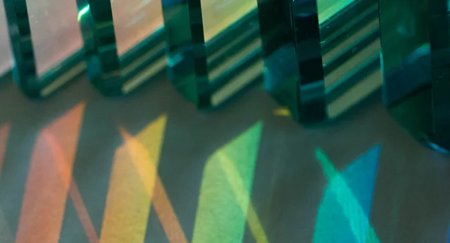
To see color, you have to have light. When light shines on an object some colors bounce off the object and others are absorbed by it. Our eyes only see the colors that are bounced off or reflected. The first person to discover the link between color and light was scientist Sir Isaac Newton.
Pure white light, such as sunlight, is composed of the visible colors. Sir Isaac Newton discovered this in 1666 by passing a beam of light through a prism.
The renowned English scientist was 23 years old at the time. He was made to stay home from Cambridge University for over a year because the plague that was sweeping Europe had closed it down. It was during this period that Newton performed his famous spectrum experiments. To alleviate the boredom of quarantine, he punched holes in the curtains of his darkened room to study the effects of light passing through a prism.
The light separated into the same progression of colors found in the natural rainbow.
Although he found an infinite number of colors in this spectrum, Newton wanted to show that there were just seven main colors, like the seven known planets and the seven musical notes in the diatonic scale. He identified red, orange, yellow, green, blue, indigo and violet. This was also in keeping with Aristotle's seven classes of color which he thought were all mixes of black and white.
Using a second prism, Newton showed that each color in the spectrum is monochromatic--that is, composed of a single, unique wavelength which can't be further separated into other colors.
Newton's experiments showed that light can be combined to form different colors. For example, combining blue and yellow light produces a green light that appears identical to the pure green found in a prism spectrum. (Modern techniques, however, show these greens to be two very different colors. Such color pairs are called metamers because they appear to be identical even though they have different wavelengths.)
Using two prisms, Newton found that some color combinations produce pure white instead of colored light. In effect, they complete each other when mixed. These pairs of colors are called complements. In this example you see that purple and yellow lights combine to form white.
As Newton discovered, sunlight is composed of 7 primary colors, which are visible when passed through a prism: red, orange, yellow, green, blue, indigo and violet. This mixture is known as white light. When white light strikes a white object, it appears white to us because it absorbs no color and reflects all color equally. When it strikes a colored object, this color light is reflected back. A black object absorbs all colors equally and reflects none, so it looks black to us. Artists consider black a color, but scientists do not, because black is the absence of all color.
In traditional color theory (used in paint and pigments), primary colors are the 3 pigment colors that cannot be mixed or formed by any combination of other colors. These primary colors are Red, yellow and blue. All other colors are derived from these 3 hues.
Secondary colors — orange, green and purple — are formed by mixing the primary colors, and tertiary colors can be produced by mixing a primary and a secondary color.
When working with color, particularly in design and print, we distinguish two methods: additive and subtractive. On a monitor, display or television screen, colors consist of red, green and blue (RGB). But when it comes to printed media, prints or paint for objects or dyes, cyan, magenta and yellow (CMY) form the basis to compose colors. We call working with RGB the additive use and working with CMY the subtractive use of color.
Additive colors are colors created by mixing two or more colored light sources together. The RGB color system is an example of additive color, as it combines the primary colors, red, green and blue, in various degrees to create a variety of different colors. When all three of the colors are combined to their full extent, they create pure white. However, when they are combined to the lowest degree, they create black.
On the other hand, subtractive colors are created by completely or partially absorbing (also called subtracting) some light wavelengths and reflecting others. Subtractive colors begin as white. As you add filters to the white light, such as ink, this white light takes on the appearance of color. The CMYK color system is an example of subtractive color use, as photos, magazines, and any printed material use subtractive color to reflect and absorb light in order for us to see.
Find out more about the different uses of color in design and print in our article on Color Spaces.
Discover even more guides and resources to help you get to grips with color theory and management within the Pantone color system — and beyond.